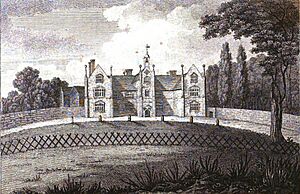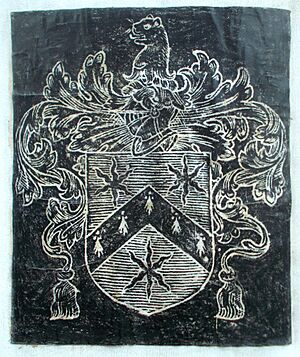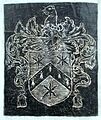Robert Brewster (Roundhead) facts for kids
Robert Brewster (born 1599, died 1663) was an English landowner. He supported the Roundheads, who were on the side of Parliament during the English Civil War. He was a member of the House of Commons, which is like a part of today's Parliament. He served there at different times between 1645 and 1659.
Contents
The Brewster Family at Wrentham Hall
The old brick mansion called Wrentham Hall was built around 1550. It was built by Humphrey Brewster (who lived from about 1527 to 1593). He was the older son of Robert Brewster.
Humphrey Brewster became the owner of the Wrentham Southall estate in 1576. He also bought the Wrentham Northall estate in 1577. This meant he owned both parts of Wrentham.
The Brewster family was given a special family symbol, called a coat of arms, in 1561. It showed a beaver's head. Humphrey Brewster married Alice Forster. He died in 1593, and his memorial is in Wrentham church.
His older son, Francis Brewster (1566-1644), took over Wrentham Hall. Francis married Elizabeth Snelling. He was a local judge and helped manage the county.
Robert Brewster, the son of Francis, went to Pembroke College, Cambridge in 1617. He married Amy Corbet. They had two sons, Francis (who died in 1671) and Robert (who died in 1681). Amy's brother, Miles Corbet, was a regicide, meaning he was involved in the trial and execution of King Charles I.
Robert Brewster and Parliament
In March 1643, Robert Brewster was chosen to be part of a special committee in Suffolk. This committee helped take over the property of people who were against Parliament. In August, he was named a "Deputy Lieutenant" for several counties, including Suffolk. Their job was to organize defenses against armies that supported the King. Robert helped raise money and soldiers for the Parliament's army.
In 1645, Robert Brewster was elected as a Member of Parliament for Dunwich. Dunwich usually had two Members of Parliament.
Robert and his brother Francis were also part of a committee that looked into church ministers. They investigated William Fenn, the parson of Theberton, and he was removed from his position.
After 1648, Robert's brother, Francis Brewster (1600-1657), helped start a Congregational church in Wrentham in 1649. Francis was later recommended to Oliver Cromwell, who was the leader of England at the time.
In 1653, Robert Brewster, as a local judge, helped officially appoint Parish Registrars for local towns. Both Robert and Francis were also on a committee in 1654 that removed ministers who were considered "scandalous." They also reported details about ministers and their communities to Oliver Cromwell.
Robert Brewster continued to serve in Parliament. He was the only representative for Dunwich in the Rump Parliament until 1653. In 1654, he was again the only representative for Dunwich in the First Protectorate Parliament.
In 1656, Robert's son, Francis Brewster, became the MP for Dunwich. Robert himself became an MP for the whole county of Suffolk. He supported the idea of offering the Crown (making him King) to Oliver Cromwell.
In 1659, Robert was again an MP for Dunwich. His brother, Humphrey Brewster (1602-1669), also served in the Parliamentary Army. He became a Lieutenant-Colonel and was in charge of Landguard Fort for a time.
Robert Brewster's Death
Robert Brewster died in 1663. He was buried in St Nicholas' Church in Wrentham, where there is a memorial for him.
His son, Francis Brewster, took over Wrentham Hall after him. Francis died in 1671, and then his brother Robert (who died in 1681) became the master of Wrentham Hall.
The Brewster family's coat of arms is described as "sable a chevron ermine between three estoiles argent." Their family motto was "Verité soyet ma Garde," which means "Truth be my Guard."
Images for kids





